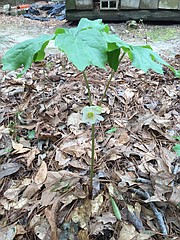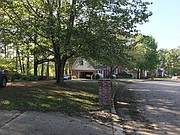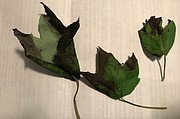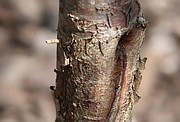Q This flower comes up each spring in the woods behind our house. Was wondering if you could tell what it is?
A The flower in the picture is a native mayapple, Podophyllum peltatum. The flowers are quite showy but often obscured by the large leaves. The plants can colonize and form large patches in the shade. After the flower, a small fruit is formed that turns gold when ripe. If you can get to them before the wildlife, some gardeners make jelly from them. But don't eat the leaves or roots, as they are poisonous.
Q Attached are pictures of our maple tree that is severely shedding right now. The worst damage is on the east side (if that matters) but damage is all over the tree. I would estimate that 40%-50% of the leaves have fallen off, most of them overnight. I've also included a pic of the whole tree that shows the shed leaves on the street. It did this last year but on a much smaller scale.
A You have anthracnose, a fungal disease. There is really nothing you can do at this point. The disease is worse in a wet spring. It is possible the tree could come close to defoliation, but it won't kill the tree. New leaves should come back on as warmer, drier weather arrives. Rake up the damaged leaves and destroy them. Take care of the tree by watering when dry this summer. If this were to happen every year, then it could pose a problem. The only time sprays are effective is when the buds are beginning to break as the new leaves begin to appear.
Q I planted an ornamental cherry tree last spring. It grew well, and I had quite a few flowers this spring. Now all the leaves are curling up and dying. I see these little things on the side of the trunk. What should I do?
A Your tree has been attacked by granulate ambrosia beetles. The beetles prefer young, thin-barked trees and are fond of ornamental cherries, redbuds, red maples and more. The small, toothpick-like protrusions you noticed on the trunk are actually strands of the sawdust-like powder that results when the female insect bores her tunnels. You are lucky to have spotted the toothpick-like protrusions, as they easily blow off with wind and rain. Unfortunately, a young tree such as yours is on its way to dying. Older, more vigorous trees sometimes survive an attack. Here is a shortcut link to a pdf with more information from the University of Arkansas Cooperative Extension Service: arkansasonline.com/418beetle.
Q Help! My azaleas have died literally overnight! The last picture is a closeup of an Encore azalea in the same bed, showing white spots on bloom (dead blooms on this one are some I had not knocked off prior to current blooming). I applied granular fertilizer about two weeks ago, and the big azalea had been blooming beautifully -- as you can see by the front of the bush. Could it possibly be fertilizer burn at this point, or do you think they were damaged by the storm and drop in temperature Wednesday night, April 8?
A Since you sent me these photos before our really low temperatures of April 14 and 15, I do not think it is cold damage. I also don't think your plants are dying, but the flowers are damaged. Normally, we don't fertilize until after the plants are finished flowering. Too much fertilizer could burn the flowers and leaves, but in the photos, I don't see any brown or damaged leaves. You didn't spray anything directly on the blooms, did you? For now, you can't reverse this. Just pay attention to watering when dry this summer, and no more fertilization. Most azaleas only need one application per year.
Retired after 38 years with the University of Arkansas Cooperative Extension Service, Janet Carson ranks among Arkansas' best known horticulture experts. Her blog is at arkansasonline.com/planitjanet. Write to her at P.O. Box 2221, Little Rock, AR 72203 or email
jcarson@arkansasonline.com
HomeStyle on 04/18/2020





